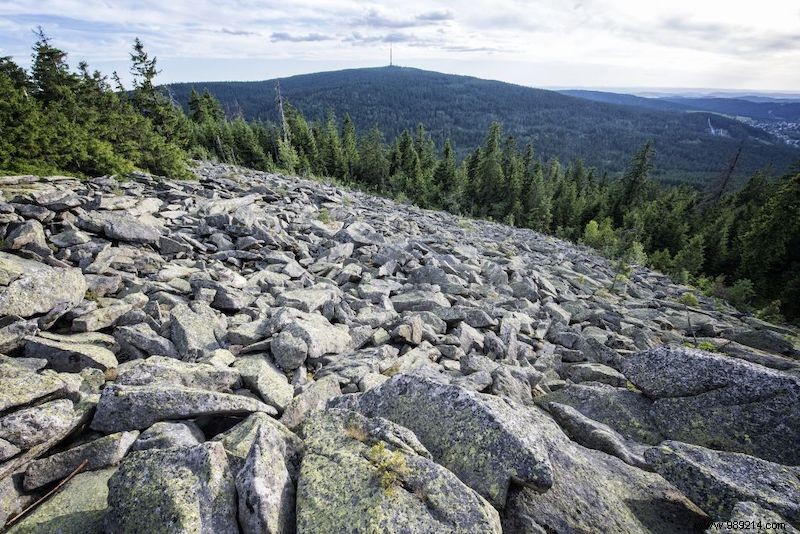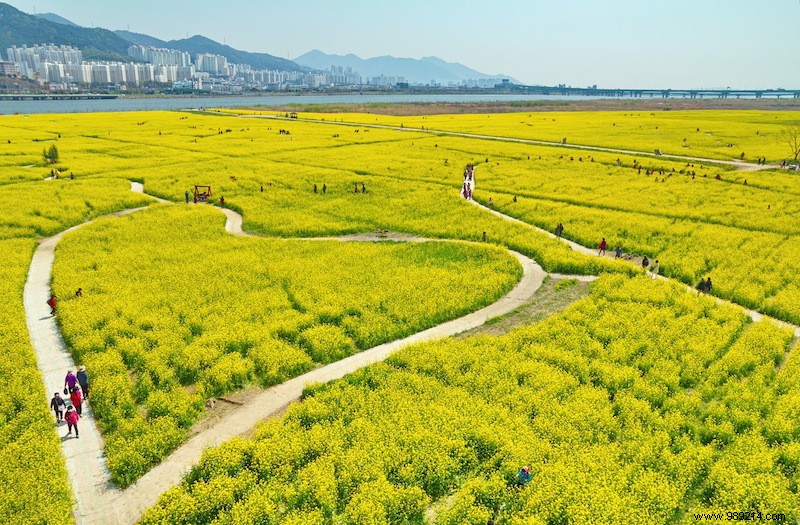Yellow and gray are the trend colors of the year 2021. The color duo will cross our paths in both fashion and interior. Nature is also not only in full bloom in spring with bright colors, and despite the different colors fits in with the zeitgeist. The hues of the badlands of the Great American West or the folk costumes of Korea made from rapeseed blossoms come very close here. 15 examples show how colorful our world is and what lies behind the colourful painting.

Crater Lake National Park,Oregon,USA
Blue Wonder in Oregon
The Oregon landscape is as diverse as it is spectacular:mighty gorges, bizarre rocks, mystical forests, rushing waterfalls, the wild coast and the deepest lake in the US at 594 meters. The crater lake in the national park of the same name was formed about 7,700 years ago after the collapse of the Mount Mazama volcano. The resulting crater in the dormant volcano filled with rain and meltwater, creating a deep azure lake with Wizard Island. The deep blue color of the lake is solely due to the purity of the water.

Grand Prismatic Hot Spring Yellowstone National Park (c) Mike Goad
The Giant Prismatic Spring in Wyoming
Blue, orange, yellow, red, green:The Giant Prismatic Spring in Yellowstone National Park is the largest hot spring in the United States and the third largest in the world. Their play of colors can be traced back to pigmented bacteria in the water and algae mats. The hot spring water with its special composition makes the colors shine. The temperature also influences the colour:while orange and red dominate in the summer, it shines in shades of green in the winter.

Badlands National Park (c) South Dakota Tourism
Ocher in the Great American West
Play of colors in ocher, red, gray and yellow can be found in the jagged stone formations of the “Badlands”. The erosional landscapes extend in the southwestern part of the state of South Dakota to more than 900 square kilometers in Badlands National Park and further north in North Dakota. The various layers of sandstone, clay, limestone and volcanic ash sparkle in colorful hues, especially at dawn and dusk. The area was given the name Badlands - bad land - from the indigenous people. Understandable, because as beautiful as the scenery of the peaks is to look at, it was once difficult and dangerous to get through.

Hawksbill Mountain (c) VisitNC.com
Indian Summer in North Carolina
From pale yellow to golden orange and deep red to deep brown, about 200 tree species in North Carolina each year create a unique color palette from September. The color and length of the spectacle is due to the heat and rain in the summer months. From the mountains in the western US state, it slowly migrates to the central region of the Piedmont. The course of the landscape and the enormous variety of deciduous trees make the Indian Summer in North Carolina one of the longest and most colorful in the world.

Madeira Fountains Path (c) Madeira Promotion Agency
Green carpet in Madeira
Hardly any other European island is as diverse as the volcanic island of Madeira. This is also reflected in the colors that can be found there:from the azure blue Atlantic Ocean to dark brown volcanic beaches and colorful flowers that sprout from the ground all over Madeira. But already when approaching the landing one can guess that the color green dominates the island. The landscape is characterized by a dense laurel forest, numerous shrubs and ferns, extensive fruit and vegetable plantations and lush vineyards along the slope. The greenery in Madeira keeps what it promises:freshness and naturalness.

Oléron Island in France (c) Thierry Richard
Wetlands on Oléron Island
Green, greener, oleron. The second largest French island and the mainland communities of the Bassin de Marennes are home to one of the most important wetlands in France. Forty percent of the area of Oléron is covered with heather. The man-made precious salt, necessary to preserve food, was produced here for centuries before the switch to oyster farming in the 18th century. Today, the swamps are a fragile ecosystem that needs to be protected.

Sea of granite blocks on the Haberstein (c) Fichtelgebirge Tourist Office_Florian Trykowski
Grays in the Fichtel Mountains
Geographers like to describe the landscape of the Fichtelgebirge as a “stone horseshoe”. The mountain ranges made of gray granite form the shape of a horseshoe open to the northeast. About 40 percent of the area consists of granite. In this abundance of stones, there is a suitable experience for active holidaymakers, those seeking tranquility or those interested in history:from rock labyrinths to cycling and hiking tours to visitor mines.

Lavender fields in southern Styria (c) Elisabeth Maier
Flowering time in Südsteiermark
In early summer, lavender colors the hilly landscapes of Südsteiermark from light blue to pale purple. On the organic farm in Wunsum, Theresia Heigl-Tötsch has been cultivating the largest organic lavender field in Südsteiermark with more than two hectares of cultivation area for eight years now. After the laborious harvest, the lavender is dried, rubbed, sieved and finally processed into more than 120 different products such as soaps, jams and special teas in the farm's own factory. At the annual lavender festival, guests get an insight into the production.

Animal Migration in Kenya (c) Governors´ Camps Collection
Great animal migration in Kenya
Every year, between July and October, millions of wildebeest, zebra and gazelle make their way from the arid regions of Tanzania to the grasslands and water sources of Kenya. This walk is long and dangerous, as enemies await both in the air and on land. At the same time, it is considered one of the most spectacular natural spectacles in Africa – in terms of color and the multitude of different animals that congregate here. The Governors' Camps are located in the middle of the Masai Mara Game Reserve. Guests can experience one of the most dramatic moments of the walk up close:crossing the Mara River, where hungry crocodiles lurk.

Cascada de Colores on La Palma (c) Jonatan Rodríguez
Painted waterfall on La Palma
The Cascada de Los Colores (“Waterfall of Colors”) is located in the Caldera de Taburiente National Park on La Palma. This small waterfall, which can be dry depending on the amount of rain, is best known for its color nuances. These are caused by the mineral-rich rocks and the mineral-rich water that flows down here. An eleven-kilometer footpath leads to this colorful site, which is located in a huge semicircular erosion crater in the northern center of the Canary Island.

Kitesurfing in Mauritius (c) Beachcomber Resorts &Hotels
Turquoise ring in Mauritius
One Eye, Manawa and Chameau are kite and windsurfing spots that regularly attract the international elite of surfers to Mauritius. But not only the mighty and challenging waves that are there are eye-catchers. Surrounding the island in the Indian Ocean is a closed coral reef, which can hardly be surpassed in its turquoise color. The best views of the lagoon and reef are revealed from the summit cross of the striking Le Morne mountain in the southwest of the island. Walks are offered from the two five-star Beachcomber Resorts &Hotels in the lee of the mountain.

Chocolate Hills
Filipino Chocolate Hills
According to myth, the Chocolate Hills on the Philippine island of Bohol were created by a tragic love story between the giant Arogo and the mortal chief's daughter, Aloya. According to the story, the giant shed huge tears after Aloya's death, half of which became trapped in the ground - and the striking mounds became today the eternal evidence of his deep sorrow. The Chocolate Hills offer unique photo opportunities, especially at sunrise or sunset – not least when the 1,250 hills turn chocolate brown in the hot summer months.

Yuchae Festival (c) Korea Tourism Organization
Korea's yellow dress
In April, South Korea wraps itself in a bright yellow, honey-scented carpet. It is the time of the rapeseed blossom. The Yuchae yellow rapeseed plant is the symbol of the volcanic island of Jeju, which is why flower festivals take place there as well as in other cities to mark its heyday. The largest collection of Yuchae flower beds in Korea can be found in Busan, more precisely in the Daejeo Ecological Park on the Nakdong River. The flower beds in Korea's second largest city currently cover more than 760,000 square meters; Visitors explore the spectacle in field labyrinths and flower paths.

Kings Canyon Rim Walk (c) Tourism Australia_Nicholas Kavo
Red Land in the Northern Territory
The imposing rock walls of Kings Canyon in Watarrka National Park in Australia's Northern Territory soar 100 meters into the air. But it is not only here that the color red shows itself in its softest and most intense shades and shades. Red also dominates in Uluṟu-Kata Tjuṯa National Park, on the Larapinta Trail, and in several other parks. Northern Territory. The best starting point to explore this region is the outback town of Alice Springs.

A sea of colors made of flowers on Izu Island, Hachijojima (c) Tokyo Convention &Visitors Bureau
Tokyo's colorful flower island
Just two hours by ferry from the Japanese capital Tokyo, the Izu Islands impress with their emerald green waters and untouched nature. When spring arrives on the island of Hachijojima, it does so in an impressive way, because then the countless freesias show themselves in full bloom. A colorful carpet of flowers of red, yellow, purple and pink hues sits at the foot of Mount Hachijo Fuji, filling the air with a delightful fragrance. The flowering time of the more than 350,000 freesias runs from March to April. During this time, visitors can stroll through the picturesque flower fields and let the splendor of color work on itself.